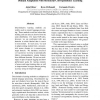1086 search results - page 16 / 218 » Knowledge-based part correspondence |
EMNLP
2006
13 years 10 months ago
2006
Discriminative learning methods are widely used in natural language processing. These methods work best when their training and test data are drawn from the same distribution. For...
IJCV
2006
13 years 8 months ago
2006
Standard approaches to stereo correspondence have difficulty when scene structure does not lie in or near the frontal parallel plane, in part because an orientation disparity as we...
ECCV
2010
Springer
12 years 2 months ago
2010
Springer
Hough voting methods efficiently handle the high complexity of multiscale,
category-level object detection in cluttered scenes. The primary weakness
of this approach is however t...
CORR
2011
Springer
13 years 3 months ago
2011
Springer
good solutions to complex problems. In many examples, individuals trying to solve superior global solution. This suggests that there may be general principles of information aggre...
MOC
2002
13 years 8 months ago
2002
This article deals with the digital inversive method for generating uniform pseudorandom numbers. Equidistribution and statistical independence properties of the generated pseudora...

